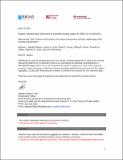Presence of Archaea in the Indoor Environment and Their Relationships with Housing Characteristics
Author(s)
Pakpour, Sepideh; Scott, James A.; Turvey, Stuart E.; Brook, Jeffrey R.; Takaro, Timothy K.; Sears, Malcolm R.; Klironomos, John; ... Show more Show less
Download248_2016_767_ReferencePDF.pdf (495.0Kb)
PUBLISHER_POLICY
Publisher Policy
Article is made available in accordance with the publisher's policy and may be subject to US copyright law. Please refer to the publisher's site for terms of use.
Terms of use
Metadata
Show full item recordAbstract
Archaea are widespread and abundant in soils, oceans, or human and animal gastrointestinal (GI) tracts. However, very little is known about the presence of Archaea in indoor environments and factors that can regulate their abundances. Using a quantitative PCR approach, and targeting the archaeal and bacterial 16S rRNA genes in floor dust samples, we found that Archaea are a common part of the indoor microbiota, 5.01 ± 0.14 (log 16S rRNA gene copies/g dust, mean ± SE) in bedrooms and 5.58 ± 0.13 in common rooms, such as living rooms. Their abundance, however, was lower than bacteria: 9.20 ± 0.32 and 9.17 ± 0.32 in bedrooms and common rooms, respectively. In addition, by measuring a broad array of environmental factors, we obtained preliminary insights into how the abundance of total archaeal 16S rRNA gene copies in indoor environment would be associated with building characteristics and occupants’ activities. Based on the results, Archaea are not equally distributed within houses, and the areas with greater input of outdoor microbiome and higher traffic and material heterogeneity tend to have a higher abundance of Archaea. Nevertheless, more research is needed to better understand causes and consequences of this microbial group in indoor environments.
Date issued
2016-04Department
Massachusetts Institute of Technology. Department of Biological EngineeringJournal
Microbial Ecology
Publisher
Springer US
Citation
Pakpour, Sepideh, James A. Scott, Stuart E. Turvey, Jeffrey R. Brook, Timothy K. Takaro, Malcolm R. Sears, and John Klironomos. “Presence of Archaea in the Indoor Environment and Their Relationships with Housing Characteristics.” Microbial Ecology 72, no. 2 (April 20, 2016): 305–312.
Version: Author's final manuscript
ISSN
0095-3628
1432-184X